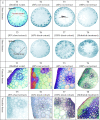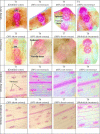Morphoanatomical and Physiological Adaptations of Triticum aestivum L. against Allelopathic Extract of Trianthema portulacastrum L. (Horse purslane)
- PMID: 37810676
- PMCID: PMC10552121
- DOI: 10.1021/acsomega.3c03238
Morphoanatomical and Physiological Adaptations of Triticum aestivum L. against Allelopathic Extract of Trianthema portulacastrum L. (Horse purslane)
Abstract
Weed infestation can be harmful to crop growth and cause severe losses in yield by absorbing nutrients and releasing inhibitory secondary metabolites and thus needs to be controlled for food security. The use of synthetic herbicides is one of the most widely applied methods, but its frequent usage is a serious threat to health and the environment and develops resistance in weeds. Allelopathy is an eco-friendly bio-control method, and Trianthema portulacastrum extracts are known to be effective against various weeds in the crop of Triticum aestivum (wheat), but their effect on the main crop (wheat) is still unknown. The pot experiment was carried out, and various concentrations (30, 60, and 100%) of root and shoot extracts of T. portulacastrum and a synthetic herbicide (Metafin Super) along with control (distilled water) were applied to the wheat plants. Various morphological, physiological, and anatomical parameters were recorded under natural conditions. The objective of this study was to explore the allelopathic impact of T. portulacastrum compared to the synthetic herbicide on the growth of wheat. This study displayed that various growth characteristics of wheat were significantly affected at p ≤ 0.05 by root and shoot water extracts of T. portulacastrum but were less inhibitory as compared to the synthetic herbicide. This inhibition of the growth of wheat was coupled with a significant increase in total free amino acids, K ions, CAT (catalase), proline, epidermal and cortical thickness, and abaxial stomatal density. In addition, a reduction in growth parameters was correlated with a decrease in photosynthetic pigments. This study revealed that the use of T. portulacastrum extracts could be safer than synthetic herbicides for wheat plants and would be beneficial to control weeds in a wheat field.
© 2023 The Authors. Published by American Chemical Society.
Conflict of interest statement
The authors declare no competing financial interest.
Figures






References
-
- Amna; Ali B.; Azeem M. A.; Qayyum A.; Mustafa G.; Ahmad M. A.; Javed M. T.; Chaudhary H. J.. Bio-Fabricated Silver Nanoparticles: A Sustainable Approach for Augmentation of Plant Growth and Pathogen Control. Sustainable Agriculture Reviews; Springer, 2021; pp 345–371.
-
- Saini A.; Manuja S.; Kumar S.; Hafeez A.; Ali B.; Poczai P. Impact of Cultivation Practices and Varieties on Productivity, Profitability, and Nutrient Uptake of Rice (Oryza Sativa L.) and Wheat (Triticum aestivum L.) Cropping System in India. Agriculture 2022, 12, 1678.10.3390/agriculture12101678. - DOI
-
- Popp J.; Pető K.; Nagy J. Pesticide productivity and food security. A review. Agron. Sustain. Dev. 2013, 33, 243–255. 10.1007/s13593-012-0105-x. - DOI
-
- Tahir O.; Bangash S. A. K.; Ibrahim M.; Shahab S.; Khattak S. H.; Ud Din I.; Khan M. N.; Hafeez A.; Wahab S.; Ali B.; Makki R. M.; Harakeh S. Evaluation of Agronomic Performance and Genetic Diversity Analysis Using Simple Sequence Repeats Markers in Selected Wheat Lines. Sustainability 2023, 15, 293.10.3390/su15010293. - DOI
-
- Ali H.; Tahir M.; Nadeem M. A. Determining Critical Period of Weed Competition in Wheat under Different Tillage Systems. Pak. J. Life Soc. Sci. 2014, 12, 74–79.
LinkOut - more resources
Full Text Sources
Miscellaneous

